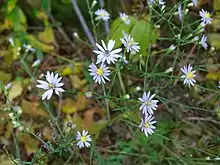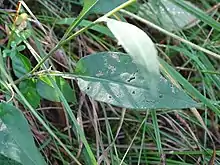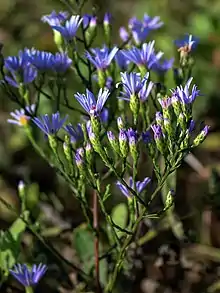Symphyotrichum oolentangiense
Symphyotrichum oolentangiense (formerly Aster oolentangiensis and Aster azureus), commonly known as skyblue aster[4] and azure aster,[3] is a species of flowering plant in the family Asteraceae native to eastern North America.
| Symphyotrichum oolentangiense | |
|---|---|
 | |
| Inflorescence, Ontario, Canada | |
| Scientific classification | |
| Kingdom: | Plantae |
| Clade: | Tracheophytes |
| Clade: | Angiosperms |
| Clade: | Eudicots |
| Clade: | Asterids |
| Order: | Asterales |
| Family: | Asteraceae |
| Tribe: | Astereae |
| Subtribe: | Symphyotrichinae |
| Genus: | Symphyotrichum |
| Subgenus: | Symphyotrichum subg. Symphyotrichum |
| Section: | Symphyotrichum sect. Symphyotrichum |
| Species: | S. oolentangiense |
| Binomial name | |
| Symphyotrichum oolentangiense | |
 | |
| Native distribution[2][3] | |
| Synonyms[2] | |
|
Basionym
Alphabetical list
| |
Description
The plants are 20 to 150 centimeters (3⁄4 to 5 feet) tall with one to several herbaceous stems. The alternate and simple leaves have a rough texture. The composite flowers, produced between August and October, have blue to violet rays.[3]


Taxonomy
American botanist John Leonard Riddell originally described this species in a publication dated to April 1835 as Aster oolentangiensis[5] after finding it in forests on the Olentangy River near Worthington, Ohio. Riddell originally misspelled the name of the river with two Os.[6] The synonym Aster azureus has also been used, but this was not published until November 1835,[note 1] so Riddell's epithet has priority.
Along with many other species, Symphyotrichum oolentangiense was formerly included in the genus Aster. However, this broad circumscription of Aster is polyphyletic, and the North American asters are now classified in Symphyotrichum and several other genera.[7]
Distribution and habitat
Symphyotrichum oolentangiense is found in prairies, open woodlands, savannahs and other open habitats. It occurs widely in the Midwestern United States and in eastern prairies, from Texas to Minnesota. It also extends into Mexico in Coahuila and to Ontario in Canada.[3] The species is endangered in New York.[8]
Ecology
The flowers attract a wide variety of insect species, including bees, bee flies, butterflies, beetles, and others. A wide variety of herbivorous insects also consume the vegetation. The seeds are dispersed by wind. The species is typical of higher quality natural areas, especially those with disturbances such as wildfire.[9]
Notes
- The name Aster azureus was published in the Companion to the Botanical Magazine 1: 98.[note 2] The cover page only dates this to 1835; this part was published in November.[note 3]
- IPNI 2020a.
- Stafleu & Cowan 1979.
Citations
References
- Brouillet, L.; Semple, J.C.; Allen, G.A.; Chambers, K.L.; Sundberg, S.D. (2006). "Symphyotrichum oolentangiense". In Flora of North America Editorial Committee (ed.). Flora of North America North of Mexico (FNA). Vol. 20. New York and Oxford: Oxford University Press. Retrieved 22 January 2020 – via eFloras.org, Missouri Botanical Garden, St. Louis, MO & Harvard University Herbaria, Cambridge, MA.
- Hilty, J. (2020). "Skyblue Aster". Illinois Wildflowers (www.illinoiswildflowers.info). Retrieved 22 January 2020.
- IPNI (2020a). "Aster azureus Lindl". International Plant Names Index (IPNI). Royal Botanic Gardens, Kew; Harvard University Herbaria & Libraries; Australian National Botanic Gardens. Retrieved 22 January 2020.
- IPNI (2020b). "Aster oolentangiensis Riddell". International Plant Names Index (IPNI). Royal Botanic Gardens, Kew; Harvard University Herbaria & Libraries; Australian National Botanic Gardens. Retrieved 22 January 2020.
- NatureServe (2 July 2021). "Symphyotrichum oolentangiense Sky Blue Aster". explorer.natureserve.org. Arlington, Virginia. Retrieved 5 July 2021.
- POWO (2019). "Symphyotrichum oolentangiense (Riddell) G.L.Nesom". powo.science.kew.org. Royal Botanic Gardens, Kew. Retrieved 5 July 2021.
- Riddell, J.L. (1835). "Synopsis of the flora of the western states". Western Journal of the Medical and Physical Sciences. 8: 490–556.
- Semple, J.C. (27 April 2021). "An overview of "asters" and the Tribe Astereae". www.uwaterloo.ca. Ontario. Archived from the original on 27 May 2021. Retrieved 6 July 2021.
- Stafleu, F.A.; Cowan, R.S. (1979). "3005. Companion to the Botanical Magazine". Taxonomic Literature: A selective guide to botanical publications and collections with dates, commentaries and types (H–Le). Vol. II. Utrecht: Bohn, Scheltema & Holkema. pp. 293–294. Retrieved 22 January 2020.
- USDA, NRCS (2014). "Symphyotrichum oolentangiense". The PLANTS Database (plants.usda.gov). Greensboro, North Carolina: National Plant Data Team. Retrieved 6 December 2015.
- Young, S.M.; Spencer, E.; Ring, R.M. (2 April 2013). "Online Conservation Guide for Sky-blue Aster (Symphyotrichum oolentangiense)". acris.nynhp.org. New York Natural Heritage Program. Retrieved 1 August 2018.
